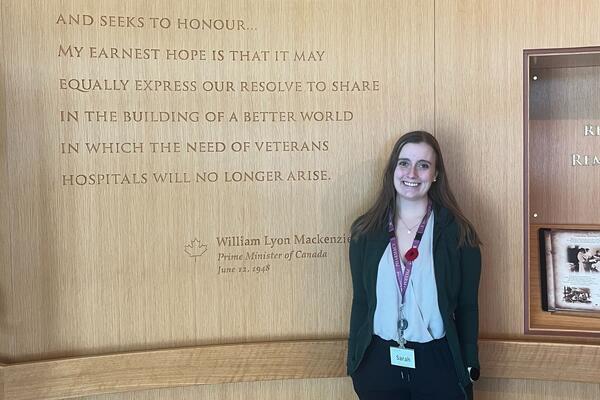
A model for northern eye care
Eye clinic at Churchill Health Centre the first to use donated optometric equipment being kept in Northern Manitoba

Eye clinic at Churchill Health Centre the first to use donated optometric equipment being kept in Northern Manitoba
By Karen Kawawada School of Optometry and Vision ScienceIt’s cold outside but the view of Hudson’s Bay is beautiful from the Churchill Health Centre (CHC), where dozens of patients got their eyes examined this week, some for the first time in years, thanks to state-of-the art equipment donated through the University of Waterloo School of Optometry & Vision Science.
The eye clinic, which took place from October 23 to 25 in the northern Manitoba town of about 900 people, was the first to pilot an initiative co-led by the School, the Manitoba Association of Optometrists (MAO) and the CHC.

The School provided a complete set of optometric equipment, which will stay in Churchill, thanks to a contribution from an anonymous donor. The new equipment is teleoptometry-enabled, providing patients with access to remote follow-up care if necessary.
By keeping optometric equipment in Churchill rather than relying on visiting optometrists to bring their own, it becomes possible to hold eye clinics more often. Teleoptometry can fill in the gaps between in-person clinics.
“Eye health is so important, whether for children who need to see the blackboard to learn or for older people whose sight might be threatened by eye disease, yet many people don’t have access to regular eye exams,” said Dr. Stanley Woo, director of the School. “This partnership highlights what collaboration can do for people in northern and remote regions.”
“Access to care shouldn’t be dependent on where you live,” said Dr. Allison Van Dyck, the Winnipeg-based optometrist who undertook the pilot visit along with an optometric assistant. “Having the equipment there and available makes these visits much more doable.”
Churchill is about 1,000 kilometres north of Winnipeg, on Hudson’s Bay. It’s surrounded by even more remote Indigenous communities, some of which are fly-in only.
“For people in Churchill, the nearest optometrist’s office is in Thompson, a 16-hour overnight train ride away, or they can fly to Winnipeg, which might be a $2,000 round trip,” said Jason Klainchar, executive director of the CHC.
During her visit, Van Dyck saw people with broken or scratched-up glasses and people wearing glasses from a few prescriptions ago. She also saw people who hadn’t been examined in several years despite being at high risk for diseases such as diabetic retinopathy, which can lead to vision loss. Van Dyck explained how some patients were surprised by how high-tech the equipment was because the more portable equipment they’d seen before was quite manual.
“I’ve received some feedback from a few community members who expressed gratitude for the service and how well it all went,” said Klainchar.

From now on, patients will have their records kept on file to ensure monitoring and continuity of care, though different optometrists recruited through the MAO may visit. Patients who need urgent treatment can be referred to clinicians in Winnipeg. A pilot to test teleoptometry for local triaging is being planned.
The CHC is also training a staff member to assist with optical services so patients will be able to try on frames and order glasses even between optometrist visits.
The partners plan more eye clinics in Churchill – and possibly elsewhere. The next step is to reach out to leaders in surrounding Indigenous communities to understand their needs and learn whether it would be helpful to bring patients from those communities to Churchill or to visit directly.
“Being able to see patients in or near their home communities is a win for everyone,” said Dr. Cody van Dijk (OD ’16), a Winnipeg optometrist and MAO member helping organize the initiative. “We can see patients who aren’t able to travel long distances and we can save the health care system money.”
That the new equipment is equipped for teleoptometry is a boon to optometry students and residents, who may in the future interact with patients in Northern Manitoba and learn how to increase access to effective and compassionate eye care.
“Teleoptometry has tremendous potential to support education and training opportunities for optometry students to see the impact of outreach models of care,” said Woo. “We’re hoping to use this as a model not only for Northern Manitoba, but also for other northern and remote regions. Ultimately, we’re working to make eye and vision care more accessible and equitable for all.”

Read more
Here are the people and events behind some of this year’s most compelling Waterloo stories

Read more
Waterloo pharmacy alum and Sunnybrook Health Science Centre team deliver compassionate care to those who have served in the Canadian military

Read more
More than 20 founders from Waterloo highlight the newly unveiled list that celebrates those making the biggest impact inside Canadian tech and innovation
The University of Waterloo acknowledges that much of our work takes place on the traditional territory of the Neutral, Anishinaabeg, and Haudenosaunee peoples. Our main campus is situated on the Haldimand Tract, the land granted to the Six Nations that includes six miles on each side of the Grand River. Our active work toward reconciliation takes place across our campuses through research, learning, teaching, and community building, and is co-ordinated within the Office of Indigenous Relations.